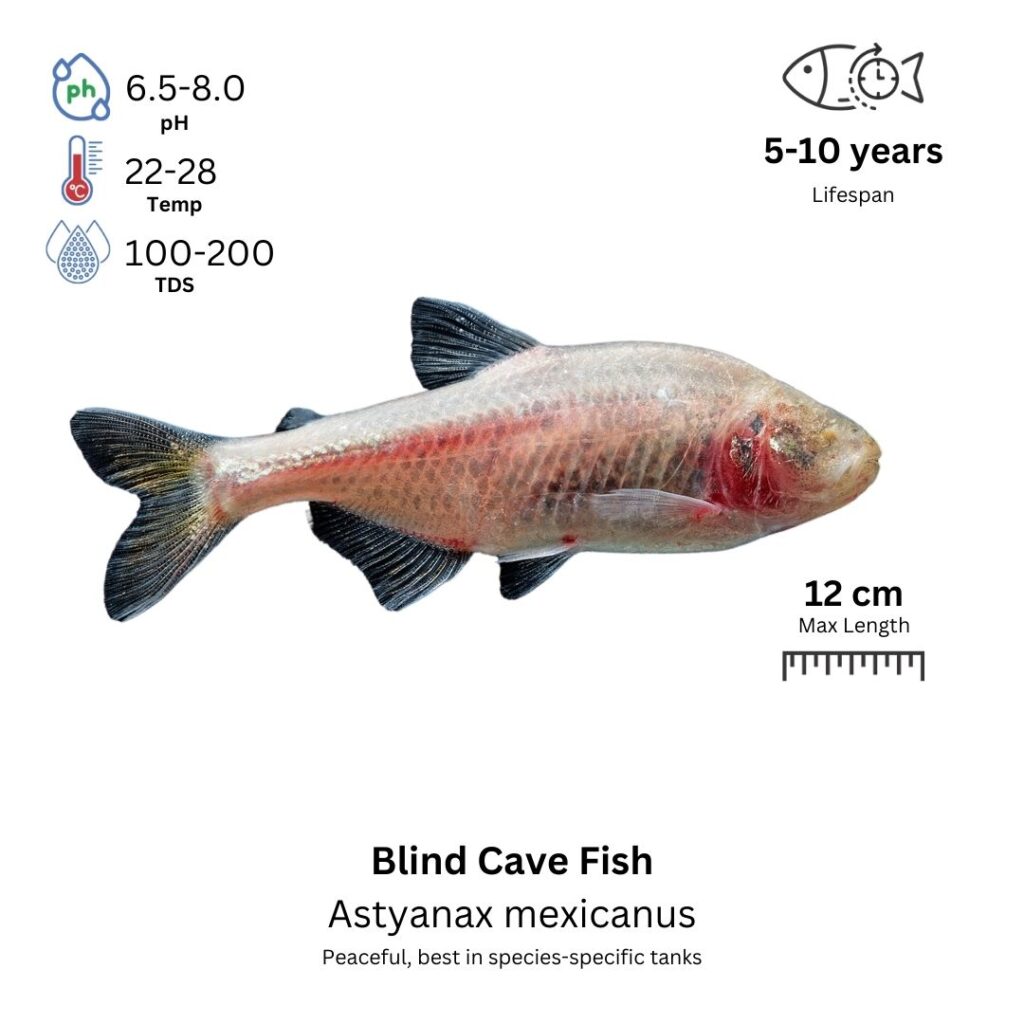Blind Cave Fish
Astyanax mexicanus

Description
The Blind Cave Fish is a fascinating species of fish, known for its unique adaptations to life in complete darkness. The most notable feature of this species is its lack of functional eyes, a result of living in the dark caves of Mexico, where light does not penetrate. The fish has a smooth, pale body, typically grey or white, due to the absence of pigmentation, and its skin may appear translucent. In its wild form, this fish has a more typical appearance with eyes and pigmentation, but the cave-dwelling variety, which is often kept in aquariums, has evolved to survive without sight.
Habitat Origin
Native to the caves of Mexico, specifically in the cave systems of the Sierra de El Abra, located in northeastern Mexico. These fish are found in subterranean waters that are devoid of light, where they have adapted over many generations to live without eyes. Blind Cave Fish thrive in slow-moving, subterranean streams and pools with minimal light and abundant food sources like small invertebrates and organic debris.
Aquarium
Ideal Number in Aquarium: At least 6 individuals, as they are social and thrive in schools.
Favorite Food

Blind Cave Fish are omnivores and will eat a variety of foods, including high-quality pellets, flakes, and live or frozen foods such as brine shrimp, bloodworms, and daphnia. They are also known to graze on algae, detritus, and small invertebrates. A varied diet is important for maintaining their health, especially since they tend to forage actively for food in the aquarium.
Special Care:
Blind Cave Fish require stable water conditions with regular water changes to keep the water clean and well-oxygenated. They thrive in aquariums with gentle filtration, as strong water currents can be stressful for them. They are best housed in tanks with plenty of hiding places, such as caves, rocks, and plants, which provide shelter and security. Since they are blind, it is important to avoid sharp objects or decorations that could injure them. These fish also benefit from a dimly lit tank, as they are adapted to living in low-light conditions.
Behavior:
Blind Cave Fish are peaceful and social, often seen swimming in groups. Despite being blind, they are highly sensitive to water vibrations and use their lateral line system to detect movements in the water, which helps them locate food and navigate. They are active swimmers and will often explore their environment, darting around in search of food or interacting with tankmates. They are generally peaceful but can become territorial during feeding times or when there are limited hiding spots. These fish do best when kept in schools to encourage natural behavior and reduce stress.
Compatibility with Other Fish:
Yes, Blind Cave Fish are generally peaceful and can be housed with other small, non-aggressive species. They can coexist with other species that do not compete for food or invade their territory. Suitable tankmates include peaceful species like tetras, rasboras, and small catfish. It is best to avoid housing them with large or aggressive fish that may intimidate or harm them. Due to their blindness, they are more vulnerable than other fish and should be kept with species that do not pose a threat.
Breeding Tank Setup
A separate breeding tank is highly recommended for Blind Cave Fish to maintain control over environmental factors and ensure undisturbed spawning. An 80–100 liter tank (20–26 gallons) provides ample space for swimming and territorial behavior. The ideal water parameters are: pH 7.0–8.0, temperature 22–28°C (72–82°F), and soft to medium hardness (4–12 dGH). Use a sponge filter or a low-flow internal filter to prevent fry from being sucked in. For the substrate, fine gravel or sand works well. Add smooth rocks or ceramic caves to encourage egg-laying, as Blind Cave Fish are cave spawners. Although plants aren’t essential, including moss or hardy aquatic plants can help reduce stress. Keep lighting dim or indirect, as these fish are naturally adapted to low-light cave environments.
Conditioning for Breeding
To prepare Blind Cave Fish for breeding, offer a high-protein diet rich in live or frozen foods such as brine shrimp, bloodworms, daphnia, and earthworms. Supplement with high-quality flakes or pellets to ensure balanced nutrition. Conditioning should last for at least 7–10 days. Perform a 20–30% water change a day or two before introducing the fish to the breeding tank. Slightly raise the temperature to around 28°C (82°F) to mimic seasonal changes that often trigger spawning.
Spawning Behavior
Spawning typically occurs in low light, either early morning or at night, once the fish are well-conditioned and comfortable. Males will chase and display to the females, leading them to caves or smooth surfaces for egg laying. A healthy female can produce 100–200 eggs per spawn. After spawning, remove the adult fish immediately, as they may consume the eggs if left in the tank. The adhesive eggs will stick to the substrate or cave interiors where they will develop.
Fry Hatching & Care
Eggs hatch in about 3–4 days, depending on temperature. The fry remain near the bottom or attached surfaces for another 2–3 days as they absorb their yolk sacs. Once free-swimming, feed them infusoria or liquid fry food. After a week, you can transition to newly hatched brine shrimp or finely crushed flake food. Maintain excellent water quality with small, frequent water changes (10–15% every 2–3 days). Use a sponge filter to ensure gentle water movement and avoid disturbing the fry.
Final Notes & Breeding Tips
Blind Cave Fish reach breeding maturity between 1–2 years of age. Males are typically smaller and slimmer, while females are rounder and fuller-bodied, especially when gravid. Males may also show subtler color differences or behavior changes during breeding. To prevent stress, avoid sudden fluctuations in water conditions and overcrowding. Provide a peaceful environment free from aggressive tankmates. Stable water parameters and proper diet are key to successful breeding and fry survival.
